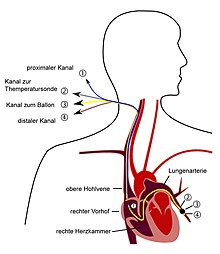Swan-Ganz catheter
The Swan-Ganz catheter (also: pulmonary artery catheter , pulmonary artery catheter , flood catheter ) developed by cardiologists William Ganz and Harold Jeremy Swan in 1970 and introduced into clinical practice is percutaneous via a central vein through the right atrium and the right ventricle into the trunk The pulmonary artery is advanced four-lumen catheter to measure the pressures in the right atrium of the heart and in the pulmonary artery, the pulmonary capillary occlusion pressure (PCWP, wedge pressure ) and the cardiac output (when using a thermistor catheter ).
It is used in intensive medicine and anesthesia and is used to monitor the cardiovascular situation in seriously ill patients.
With the help of the pressure measurement in the right heart (right atrium, right ventricle and pulmonary artery), conclusions can be drawn about the function of the left heart cavities, the function of the lungs and the body's water balance.
Possible areas of application of the pulmonary catheter are z. B. diseases with heart failure, acute respiratory insufficiency (to diagnose a possibly existing pulmonary hypertension) and cardiovascular surgery. In intensive care medicine, the catheter is used in patients with shock states of various origins (cardiogenic shock, septic shock, hypovolemic shock in multiple trauma). Based on the measured pressure values, conclusions can be drawn about the causes of the shock and treated accordingly: either with medication ( catecholamines , dissolving clots in the case of pulmonary embolism , by supplying volume (fluid and blood transfusions)) or through surgical interventions (e.g. puncture of the Pericardium in the event of hemorrhage, surgical clot removal in the case of pulmonary embolism, heart valve operation in the case of valve defects).
According to Larsen, the possible complications when using the Swan-Ganz catheter are, above all, balloon ruptures (bursting of the balloon at the end of the catheter that floats in), pulmonary infarction and vascular rupture.
Measured values that are determined with the Swan-Ganz catheter are the pressure in the right atrium , the pulmonary capillary closure pressure , the cardiac output and the systemic vascular resistance . The measured values allow differential diagnostic distinctions to be made between volume deficiency , cardiogenic shock , left ventricular and right ventricular myocardial infarction , pulmonary embolism , early and later sepsis , pericardial tamponade and acute ventricular septal rupture .
literature
- HJ Swan, W. Ganz, J. Forrester, H. Marcus, G. Diamond, D. Chonette: Catheterization of the heart in man with use of a flow-directed balloon-tipped catheter . In: The New England Journal of Medicine . tape 283 , no. 9 , 1970, ISSN 0028-4793 , pp. 447-451 , doi : 10.1056 / NEJM197008272830902 , PMID 5434111 .
- Reinhard Larsen: Anesthesia and intensive medicine in cardiac, thoracic and vascular surgery. (1st edition 1986) 5th edition. Springer, Berlin / Heidelberg / New York et al. 1999, ISBN 3-540-65024-5 , pp. 127-137.
Web links
- A. Zowislo: Possibilities of extended hemodynamic monitoring - comparison of pulmonary artery catheters and the PiCCO method in hemodynamically unstable patients. English, zwai.net ( Memento from February 7, 2009 in the Internet Archive )
- Pulmonary Artery Catheterization. emedicine.com (English) accessed July 2008
Individual evidence
- ↑ D. Scheidegger: Definition and parameters of acute respiratory insufficiency: pulmonary circulation, cardiac function. In: J. Kilian, H. Benzer, FW Ahnefeld (ed.): Basic principles of ventilation. Springer, Berlin a. a. 1991, ISBN 3-540-53078-9 , 2nd, unchanged edition, ibid 1994, ISBN 3-540-57904-4 , pp. 109-120; here: pp. 113–116 and 175 f.
- ↑ Amitava Majumder, Anne Paschen: Medical working techniques. In: Jörg Braun, Roland Preuss (Ed.): Clinic Guide Intensive Care Medicine. 9th edition. Elsevier, Munich 2016, ISBN 978-3-437-23763-8 , pp. 29-93, here: p. 40 ( differential diagnosis through pulmonary catheter findings ).

